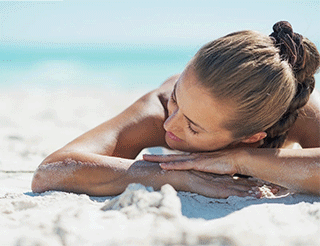Stay safe in the sun

Sunshine is good for you – but only in moderation. With the best in natural sun protection, you can make the most of the summer months, worry free
Everyone loves the feeling of sunshine on their skin, and we know that sunlight has many health benefits – as well as making us feel happier and more upbeat. But we also know that excessive exposure to the sun’s rays can be dangerous. The main cause of damaged and ageing skin is the sun, due to its UVA and UVB rays, and the number of skin cancer sufferers is rising. Worldwide, there are approximately three million skin cancer cases per year. The individual risk for developing skin cancer can be reduced by avoiding excessive sun exposure and sunburn.
The amount of time that we can spend in the sun without risk varies from person to person. Each skin type has its own natural protection time, and people with extremely sensitive skin tend to react more to the sun. If you use a cream with a sun protection factor (SPF) this will prolong the time that you can spend in the sun without getting sunburn. In general, the more fair your skin, the less time you can spend in the sun, but even those with darker skin tones can burn in the sun, contrary to what some people believe. It’s also possible to suffer the damaging effects from the sun’s rays even if you don’t burn.
Different types of sunlight
Sunlight is made up of two types of rays – UVA and UVB.

UVA rays are long-length rays which penetrate deep into the skin. The results can include:
- Loss of tightness of the skin caused by damage to the elastin and collagen fibres, which make skin supple and firm.
- Development of free radicals.
- Permanent harm to DNA
Which could result in premature skin ageing and wrinkles.
UVB rays reach their peak in intensity from 11am to 3pm in summer. They are middle-length rays which penetrate the top layer of the skin, triggering the production of melanin. The results can be:
- Sunburn – UVB radiation is the main cause of sunburn. A product with SPF 15 blocks about 92% of UVB radiation, one with SPF20 blocks about 92%, SPF 30 takes protection to 97% and SPF50 to over 98%.
- Damage to the DNA at the heart of the skin cells, one of the foremost causes of skin cancer.
Natural or chemical protection?
Mineral UV filters work differently to chemical ones. Chemical UV filters connect with the skin’s oils and convert the sunlight into heat, which is diverted from the skin. They usually take 20-30 minutes to become effective, and can be extremely allergenic.
Natural minerals (such as titanium dioxide or zinc oxide) lie on the skin and reflect the UV rays as a mirror would reflect light. They don’t penetrate the skin but form a physical barrier on top of it, work immediately after application and are not hormone active. They contain natural plant oils to nourish and hydrate the skin.
Many brands now combine mineral protection with synthetic enhancers to boost the SP factor. These chemicals can also cause skin irritation, and Organii and Lavera are two of a very small number of brands that don’t contain any synthetic enhancers.
The good news is that 100% mineral sunscreen provides you with all the protection that you need. Zinc oxide and titanium oxide provide a protective shield that instantly and effectively reflects the sun’s rays. This mineral UV filter developed by Lavera is referred to as physical sun protection in the industry. Due to the light reflection on the skin, the human eye perceives the natural minerals – pigments in the emulsion – as a white shimmer. Hence the skin appears whiter.
Articles from our latest issue...